The Perfect 3-Day Winter Weekend in Chamonix: Alpine Spas, Olympic Lore, and Powder Paradise
Chamonix is more than France’s flagship ski resort. Many out here would call it the world’s adventure sports capital—where elite alpinists race for first ascents, champion paragliders and speed wing fliers defy gravity for distance records, trail runners race through epic conditions at altitude, off-piste skiers snatch the steepies, and concepts like the Winter Olympics get their legs.
Related: This Is the Best Ski Gear We Tested for 2024
This magnificent mountain town in the French Alps—just north of Mont Blanc, Western Europe's highest peak—rightfully deserves eminent status. And this valley, blessed with some of the biggest, most beautiful glaciers and peaks in the world, has become a legendary destination for the classic ski holiday. In Chamonix, you’ll find five ski resorts within a half hour of an ultra-charming town that's home to unrivaled outdoor-sports shopping, world-class spas, and a legendary après-ski scene. While people have been farming and raising sheep and cattle in the Chamonix valley for a millennium, mountain sports culture kicked off here 200 years ago—and the Chamoniards never looked back.
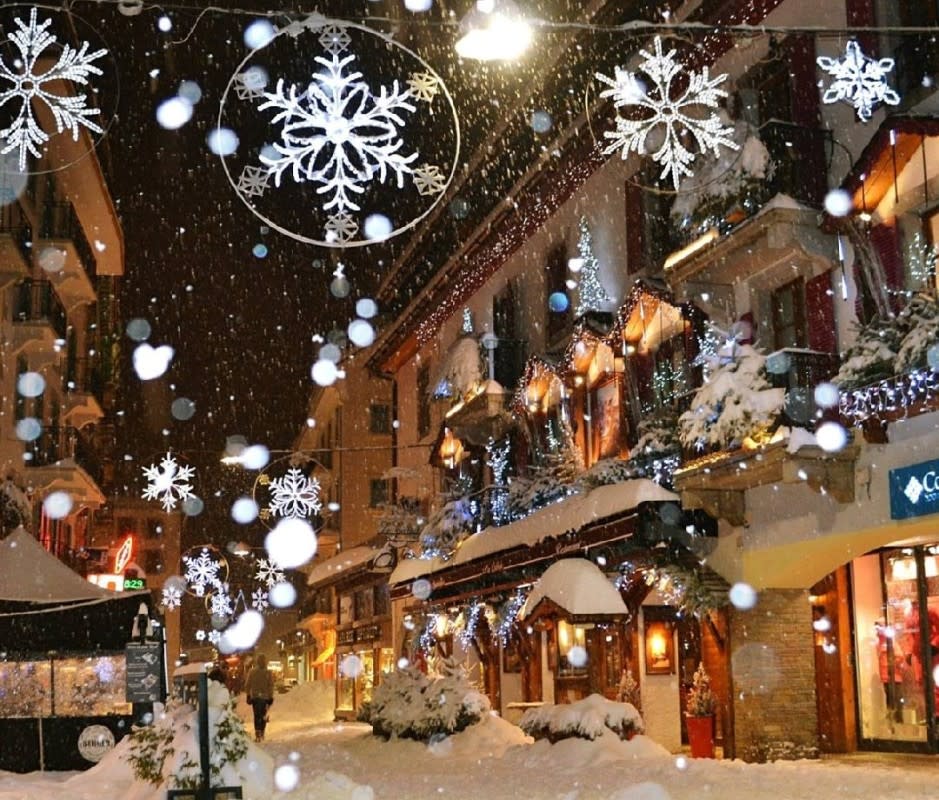
Office de Tourisme de Chamonix-Mont-Blanc
Even if you’re not ready for ski touring on the Mer de Glace or, during summer, running the UTMB (Ultra Trail du Mont Blanc), Chamonix’s stark alpine beauty, its quick access to massive glaciers, and near vertical granite faces that soar almost ten thousand feet above the valley floor are worth a visit. As for the skiing, you don’t have to be a daredevil to discover the delights of Chamonix’s abundant slopes and backcountry runs. Whether you're a beginner, an expert, or somewhere in between, there’s a perfect ski experience here waiting for you.
A bonus is that the Chamonix-Mont Blanc area (in the Haute-Savoie region) shares borders with Italy and Switzerland. You can ski (or hike) from hut to hut to explore this section of the Alps—enjoying breakfast in France, lunch in Switzerland, and dinner in Italy. With plenty of exercise in between.
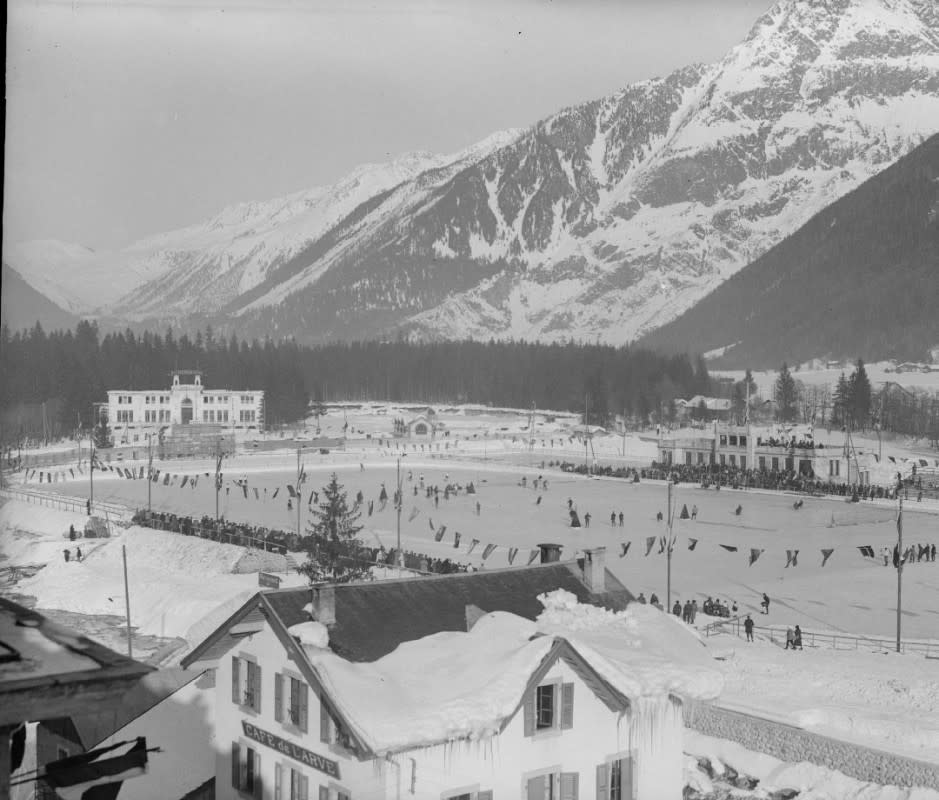
Auguste Couttet, Municipal Archives of Chamonix-Mont-Blanc, Gay-Couttet Fund
If you visit Chamonix this year, you’ll be there to commemorate the 100th anniversary of the first Winter Olympic Games, hosted here in 1924. A section of the first Aiguille du Midi cable car was completed just in time to haul bobsleds up the mountain, officially opening in the summer of 1924. The second section, added in 1927, reached an altitude of 7,600 feet—completing the first aerial tramway in France.
Related: This Hidden Spot Is Our Favorite Undiscovered Ski Getaway of 2024
After WW2, the cable car was rerouted with a new, higher-still installation from Chamonix to the Aiguille du Midi. Reaching over 12,600 feet, it remains Europe's highest cable car, offering stunning views of Mont Blanc, panoramas of the sweeping valley below, and one of the world's most thrilling ski touring runs—Vallée Blanche. A century after the Olympic Games, Chamonix remains the most hallowed ski escape in the Alps. Here’s how to experience the best of it in three spectacular, action-packed days.
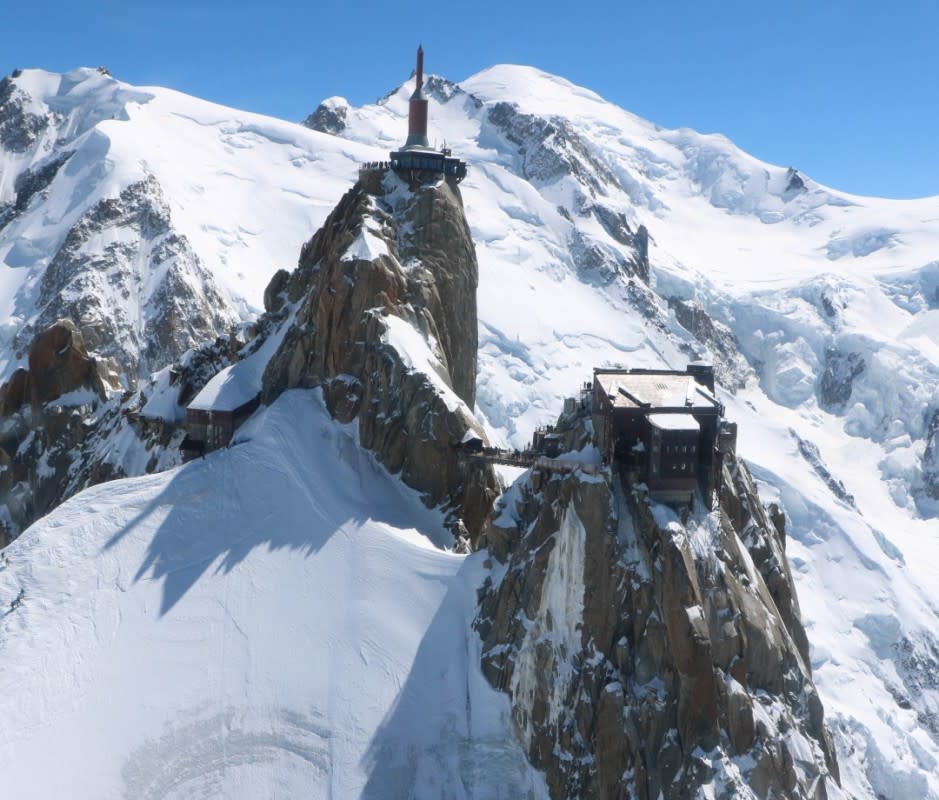
Office de Tourisme de Chamonix-Mont-Blanc
How to Get to and Around Chamonix, France
Chamonix is one the most accessible towns in the Alps to visit. The international airport of Geneva (GVA), Switzerland is about an hour (55 miles) from Chamonix by train, bus, or car. If you rent a car at the airport, you’ll have the flexibility to drive to neighboring alpine villages in the valley, including Les Praz, Argentiére, Vallorcine, Les Bossons, Le Tour, and Les Houches. You can also take a bus or get a shared airport transfer from Geneva airport to Chamonix for about 20 euros each way. A train option from the airport connects to Chamonix through St. Gervais Les Bains—an easy transfer, even if you don’t speak French. Whatever your mode of transport, remember that Chamonix is a walking town, with plenty of easily accessed public transportation to whisk you around the valley.
When to Visit Chamonix
Chamonix is popular year-round, but you can still time it right to avoid the largest crowds and dodge the steepest lodging rates. Mid-December through the end of April is high season for winter. Keep in mind that the second week of February through early March is when France’s schools are on winter break, so you’ll most likely have more competition for restaurants and hotels during that time. Summers, from mid-June through the end of September can also be busy. Low season is from May through Mid-June and October through mid-December.
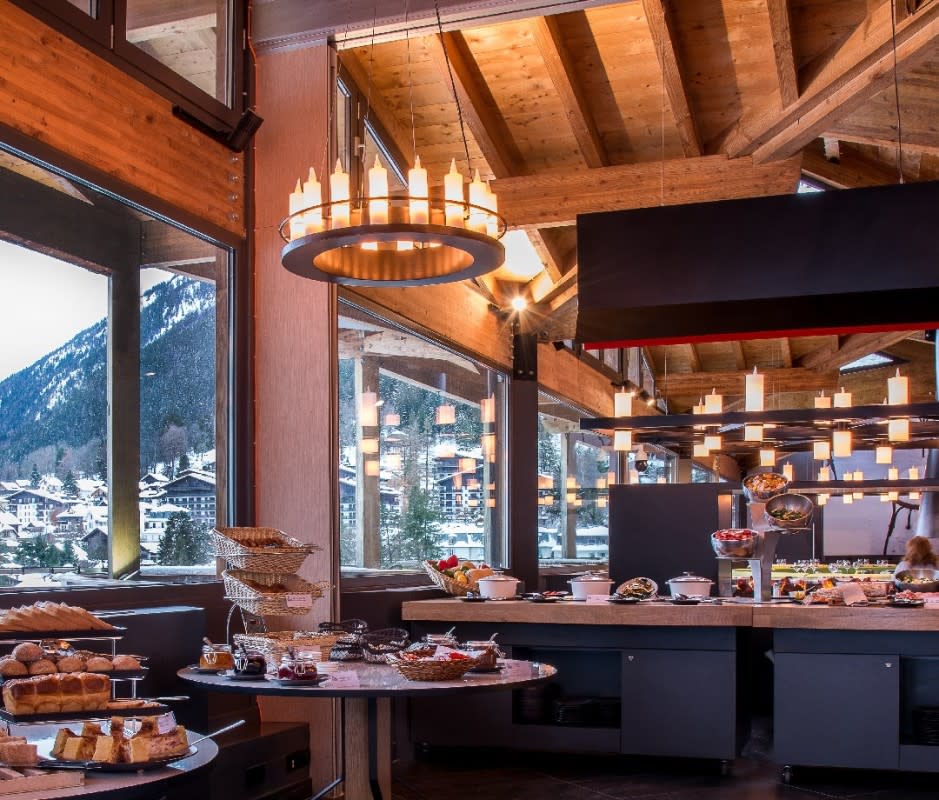
Courtesy Alpina Eclectic Hotel & Spa
Where to Stay in Chamonix
Chamonix has a wide array of hotels, lodges, hostels, and rentals to suit most budgets. While the population of Chamonix is about 9,000 (13,500 in the entire valley) there are a whopping 80,000 beds available—but you won’t find giant hotels here. It’s still an alpine town with mountain architecture. In the center of town, the Alpina Eclectic Hotel & Spa is modern on the outside and true Chamonix on the inside. At check-in, you'll be greeted with mountaineering heritage, as there are a couple of dozen climbing ropes on display, and the luggage trolleys are decorated with dozens of locking carabiners. From the hotel you're just a few minutes’ walk from the train station, the Aiguille du Midi cable car, Le Brévent ski area, and scores of fashionable restaurants, bars, and shops.
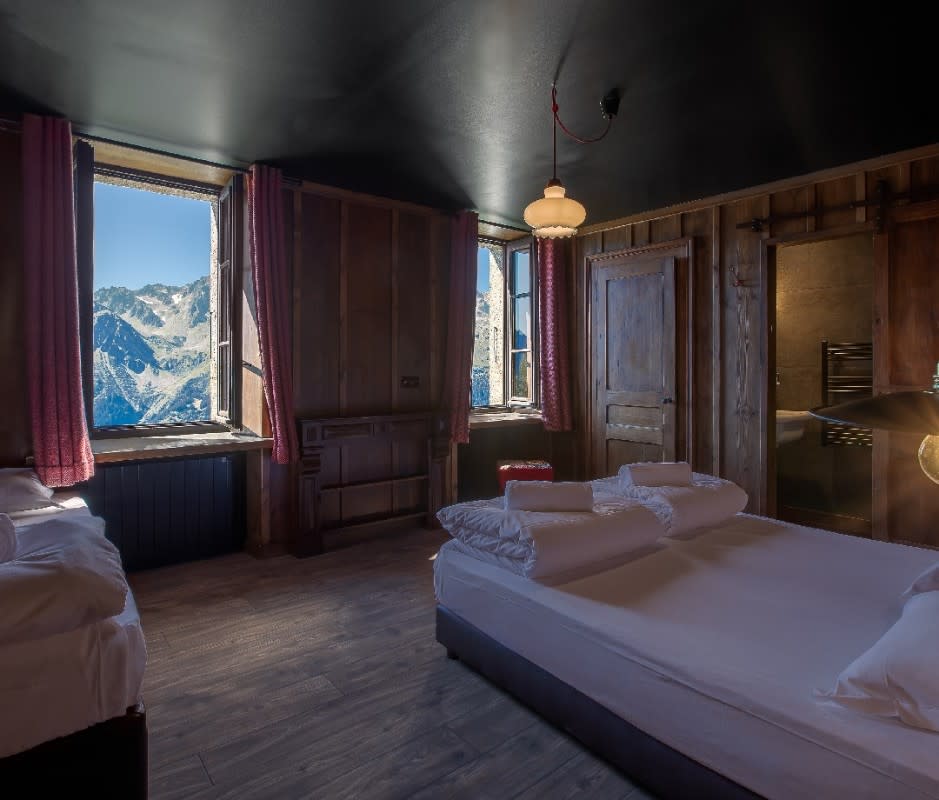
Courtesy Refuge du Montenvers
A visit to Chamonix isn’t complete without a night spent at the legendary Refuge Montenvers at the base of the Mer de Glace. It has the same ownership as the Alpina, so booking the two together is easy. We also love the historic hotels of Chamonix, many of which have been operated by multiple generations.
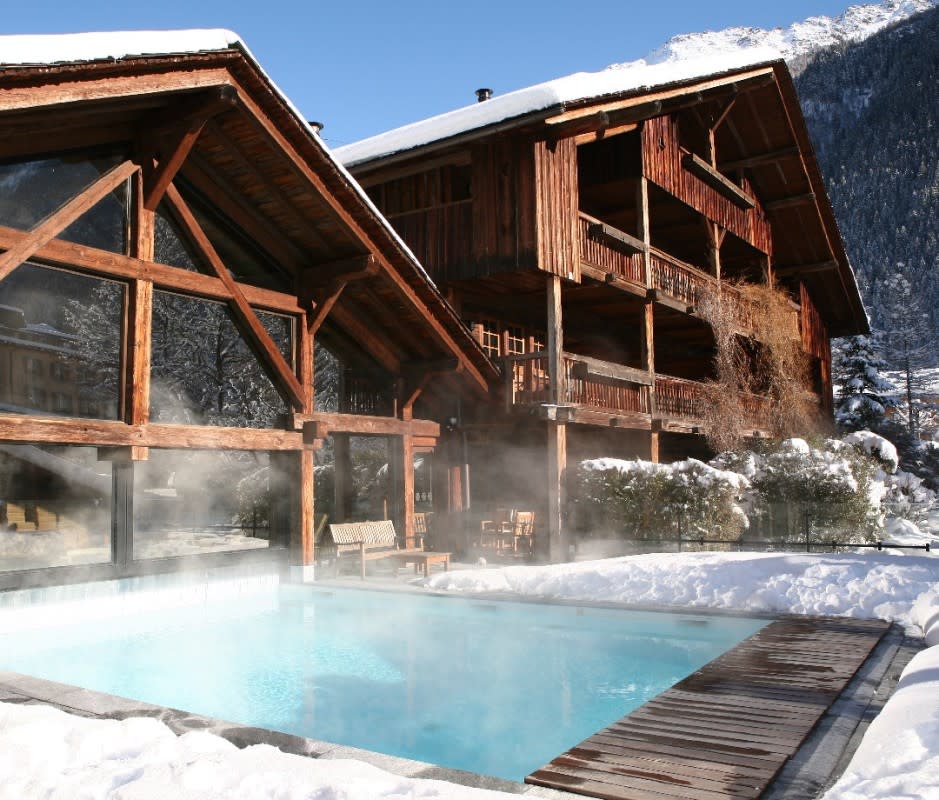
Courtesy Hameau Alber
The Hameau Albert 1er is a 5-star hotel that’s been run by the same family since 1903. You’ll get fantastic views of Mont Blanc, and a spa with both outdoor and indoor pools. There are also plenty of hostels or bed and breakfasts (gites) where you can score a reasonable place for the night.
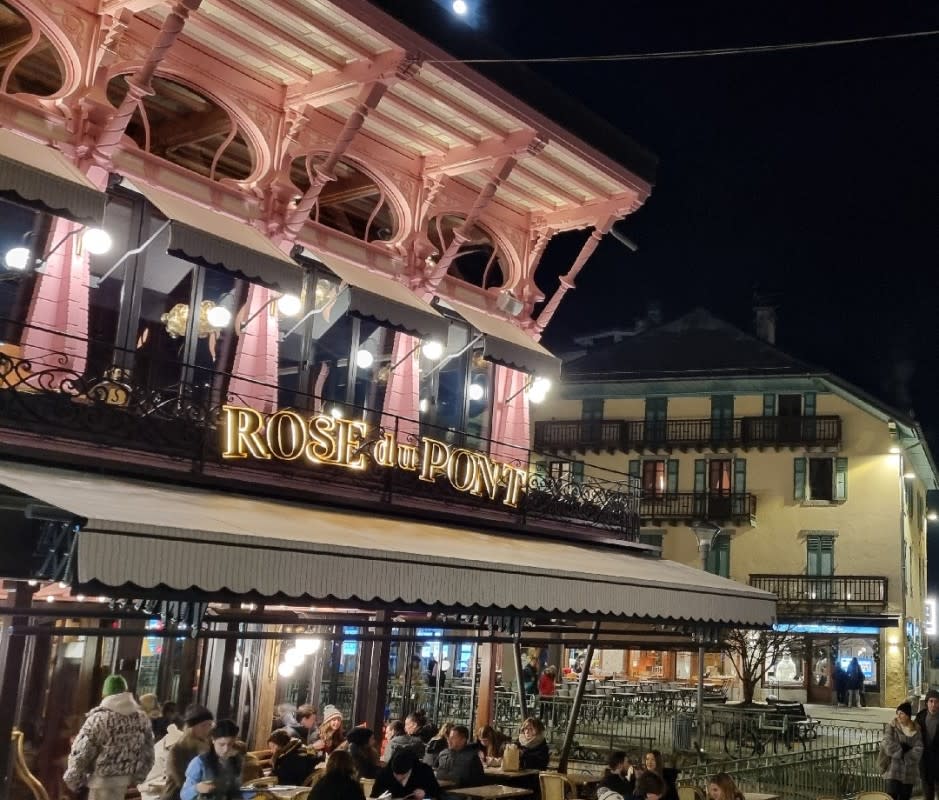
Courtesy Rose du Pont
Where to Eat in Chamonix
Food is unsurprisingly a big deal in Chamonix, with no shortage of upscale gastronomic options and plenty of delicious, moderately-priced spots too. For breakfast, grab a coffee and a pastry or a sandwich at one of the many patisseries in town before heading out for whatever adventure awaits. For lunch, Rose du Pont is a beautifully restored Parisian-style bistro. Le Royal at the Chamonix Casino is a wonderful choice for dinner, with world-class food, service, and atmosphere in a building (formerly The Palace Hotel) that's been hosting celebrities and royalty dating back to Napoleon III.
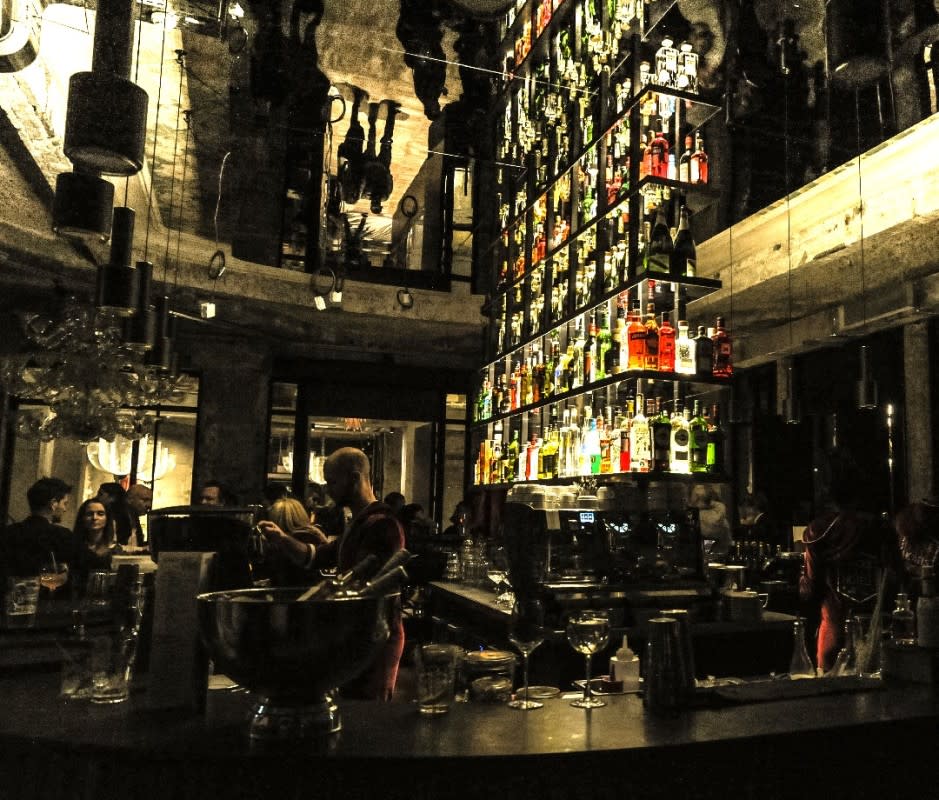
Courtesy La Folie Douce
Where to Drink in Chamonix
In Chamonix, après ski is more a state of mind than something you only do after skiing. Based in the former Club Med building, La Folie Douce is perhaps the most exotic après ski scene in town. There’s live music, cabaret, and of course, dancing on tables in your underwear if the moment strikes. Centrally located at the Savoy Hotel at the base of the Brévent gondola, the venue's giant deck offers excellent views of the Aiguille du Midi and Mont Blanc, although you’ll probably be more focused on your Kir Royale or pint of Mont Blanc Blonde.
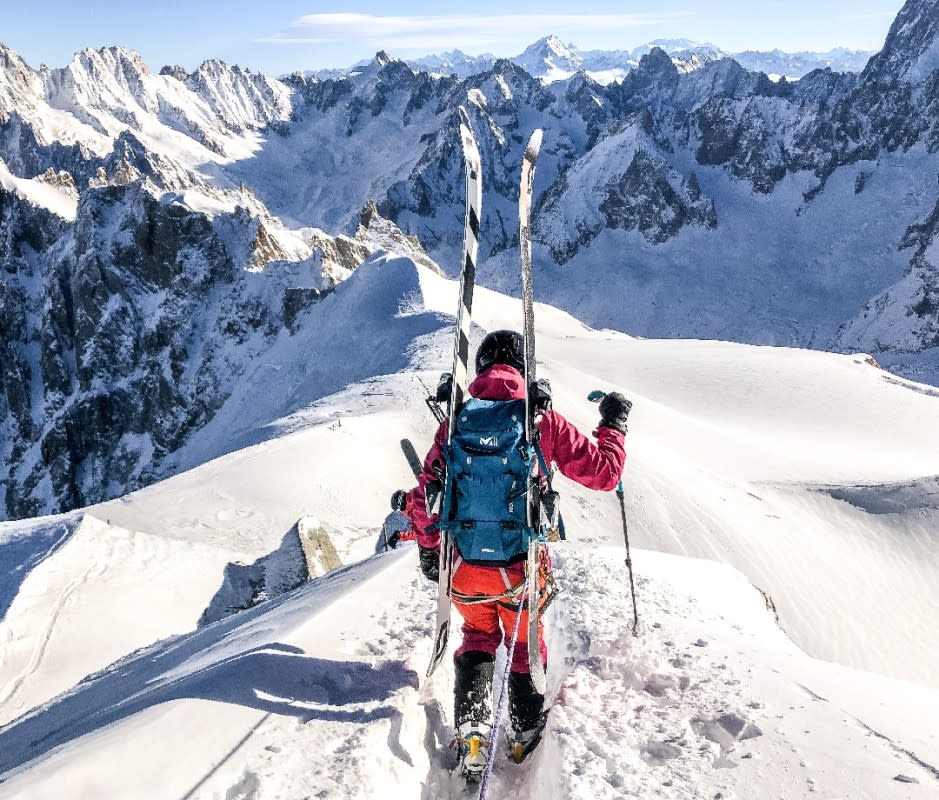
Office de Tourisme de Chamonix-Mont-Blanc
Don’t-Miss: Skiing Vallée Blanche
With five resorts in Chamonix Mont-Blanc—Grands Montets, Les Houches, Le Tour/Balme, La Flegere, and Le Brévent—there’s plenty of skiing and snowboarding for all levels. But if we had to pick one essential off-piste ski experience, that would be Vallée Blanche. The 12 mile long glacier descent covering a vertical of nearly 9,000 feet—all while surrounded by the castellated peaks dominating this part of the Alps—is tough to put into words. You just have to do it.
The ski tour starts at the top of the Aiguille du Midi gondola. You’ll need to hire a guide, as not only are local guides experts in picking the safest path for your ability, they’re also incredibly knowledgeable in the area’s history and geology. Along the way, you’ll gain a better understanding of glaciers and the huge impact of climate change. In 2025, a Glaciorium (museum dedicated to glaciers and their history) will open at the base of the Vallée Blanche.
Related: You Need to Try These 7 Essential Travel Hacks Before Your Next Ski Trip
Savvy Tips for Visitors to Chamonix
Plan on taking public transportation—or leaving your car rental in hotel parking. Chamonix is a walking town, and part of the relaxation of the alpine environment is a slower-paced ease. Dress is ski-town casual, although you can jazz it up at night when heading out to eat and party. An abundance of outdoor shops in town, from the world-class Ravanel and Snell Sports to outdoor brands like Columbia, Arc‘teryx, Fjallraven, and Mammut can swiftly fill in any gaps in your wardrobe both on and off the slopes. Plus, there’s plenty of high-end resort wear and luxury brand stores to delight the most ardent fashionistas.

Office de Tourisme de Chamonix-Mont-Blanc
Day 1: Ski Les Grands Montets, Covet Handmade Wooden Skis, and Revisit the World’s First Winter Olympics
Wake up at the Alpina Hotel and head to the 7th floor for the buffet breakfast. Your attention will be divided between the panoramic views of Mont Blanc and the custom-made omelets, pancakes, charcuterie, cheese, and fresh fruit. Grab your skis from your personal (heated) locker and head to Argentiére and the gondola at Les Grands Montets. The ski resort is about 20 minutes from Chamonix, and you can take a train or bus if you don’t have a car.
Related: This Stunning Alpine Playground Is America's Top Winter Getaway
“Les Grands” has some superb long groomed runs (piste), but you can also access some incredible off-piste and backcountry skiing, as well as abundant alpine climbing, from the cable cars. While the Grands Montets cable car that goes to the top of Argentiére Glacier is currently closed (due to a fire), experienced skiers put on skins and head up to the Col des Rachasses to access the amazing off-piste of the Argentière glacier. Stop for lunch in Les Praz, a traditional alpine village between Chamonix and Argentiére. While here, schedule a visit to Rabbit on the Roof, where you’ll find some of the best handmade skis in the world. Peter Steltzner, the California-born artist, saws ash logs, tailoring custom skis to each client’s specific needs. Rabbit on the Roof skis have won many freeride competitions, including the iconic Derby de la Meije.
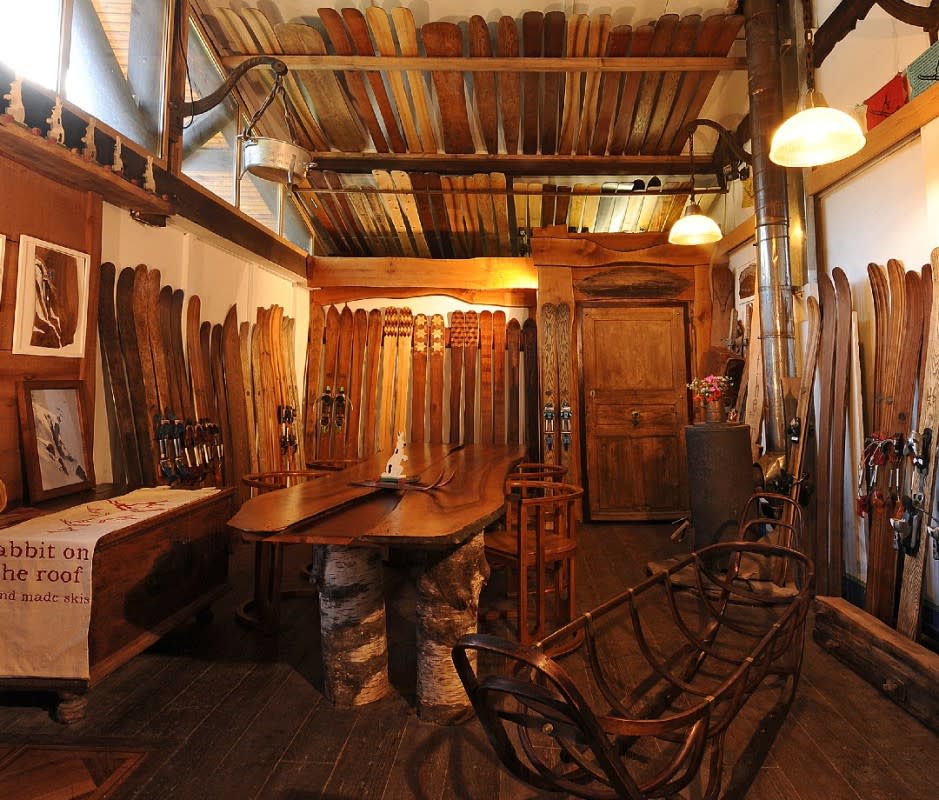
Courtesy Rabbit on the Roof
When you return to Chamonix, head over to the Office du Haute Montagne (“Office of High Mountains”), established in 1972 by Chamonix guide, Gérard Devouassoux, to check on the latest climbing conditions and check out a fantastic relief map that will help you get further oriented. Make time for the Maison de la Memoire et du Patrimoine, a museum in central Chamonix that's home to its best photographic archives, and a fascinating pictorial and video history of the 1924 Winter Olympics running through 2025.
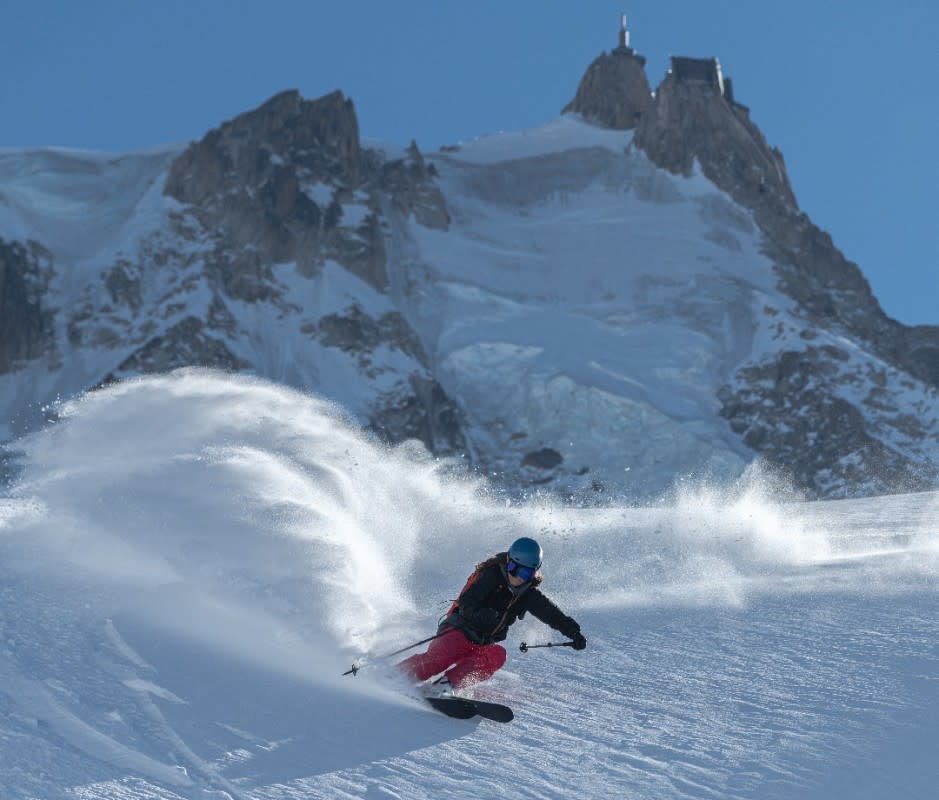
Tony Harrington
Day 2: Whiz Down a Giant Glacier, Gawk at Mont Blanc, and Recharge at Refuge Montenvers
Chamonix is home to more than 200 mountain guides—and the chances are pretty good you’ll be booking one of them through either of the town's top two guide services, Evolution 2 or the Compagnie des Guides de Chamonix. Meet your guide for the day at your hotel. From here, you’ll drive five minutes to the Aiguille du Midi cable car which sweeps you up to the top of its iconic namesake peak. You'll be wearing a climbing harness and doing a beacon check—not to climb, but to traverse a knife-edge ridge before skiing down one of the longest glaciers in Europe, led by a guide ensuring the safest route through the crevasses. It’s a ski tour that strong intermediate to expert skiers will find very doable. Mer de Glace is what originally brought tourists to Chamonix. This massive cascade of frozen ice stretches from the peaks of the mighty alps down toward the town itself.
Related: Powder Paradise: Snowcat Skiing at Colorado’s Purgatory Resort
En route, you’ll spot some of the most famous climbing walls in the Alps, notably Mont Blanc, Les Grandes Jorasses, and the Dru. Looking up at the peaks, it’s hard to imagine that the golden age of alpinism in the valley was 1854-1865—when all of the 13,000-foot peaks were summited. The first recorded summit of Mt. Blanc was in 1786, a date that is significant as the beginning of “modern” mountaineering. You’ll end your ski at the newly opened Montenvers Gondola. This takes you up the steep cliffs to the Montenvers train station, a picturesque narrow gauge railroad that has brought tourists to the glacier from Chamonix for more than 100 years.
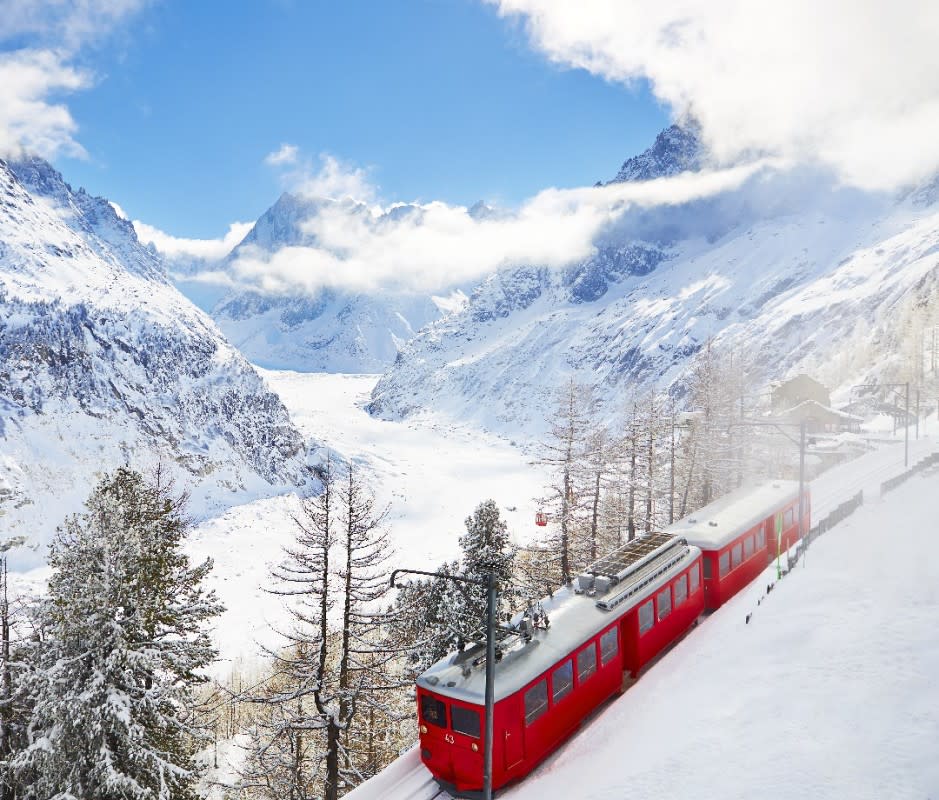
Max Coquard-Bestjobers
You can return to town, but we recommend spending the night at the Refuge du Montenvers—accessed by the Montenvers train which leaves Chamonix every half hour from 10 a.m. to 4:30 p.m. Built in 1880, the hotel has hosted the world’s greatest alpinists, skiers, writers, poets, and artists. Here, guests will instantly enter a quieter world defined by mountain history and cozy rooms with some of the most magnificent alpine views imaginable.
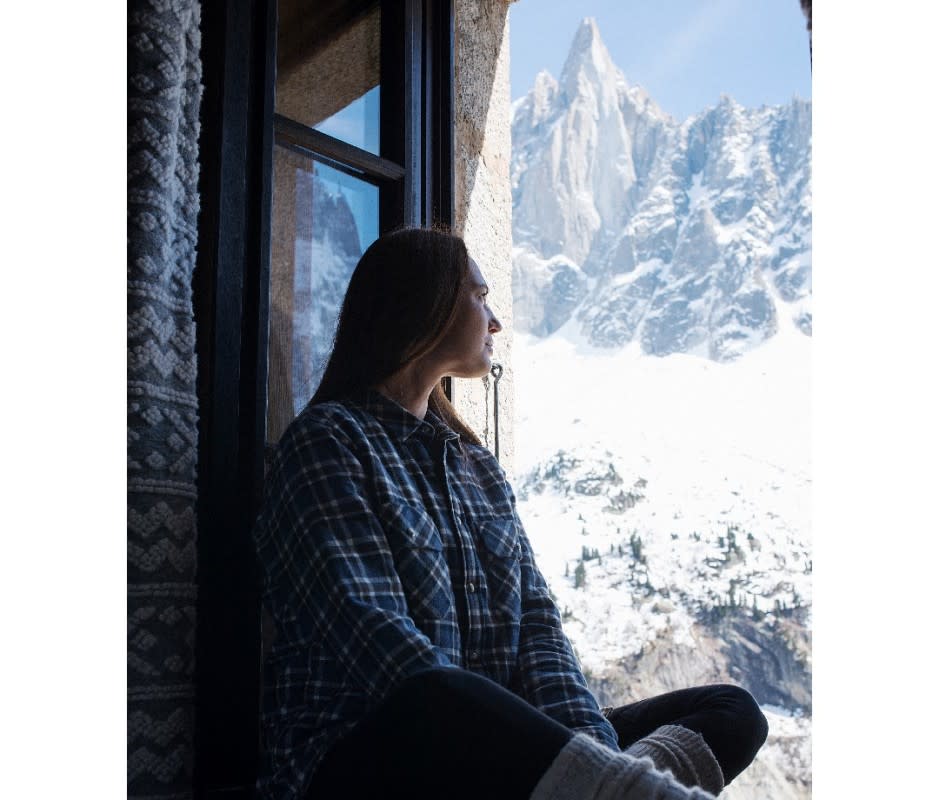
David Andre
The hotel faces the Dru and Grands Charmoz, two of the most iconic peaks in the French Alps. Grab a seat at the bar by the giant fireplace and enjoy a vin chaud and charcuterie before heading to your table. The menu (and wine list) has plenty of options, but we recommend the specialty of the house—fondue with local cheeses. Retire back to the bar for a nightcap (Génépi is the local drink). Then sleep in total quiet—save for the echoing sounds of boulders crashing down from the mountains to the glacier far below.

Courtesy QC Terme Chamonix
Day 3: Ski Le Brévent, Visit the Crystal Museum, and Soak in a Heavenly Euro-Spa
If you still have ski legs, walk to the base of Le Brévent from your hotel. Even if you don’t, take the gondola to the 8,300-foot summit for a coffee and fries. The ski area is south facing, so chances are the snow will be soft. Do a few runs and head back down for some sightseeing and deep relaxation in Chamonix.
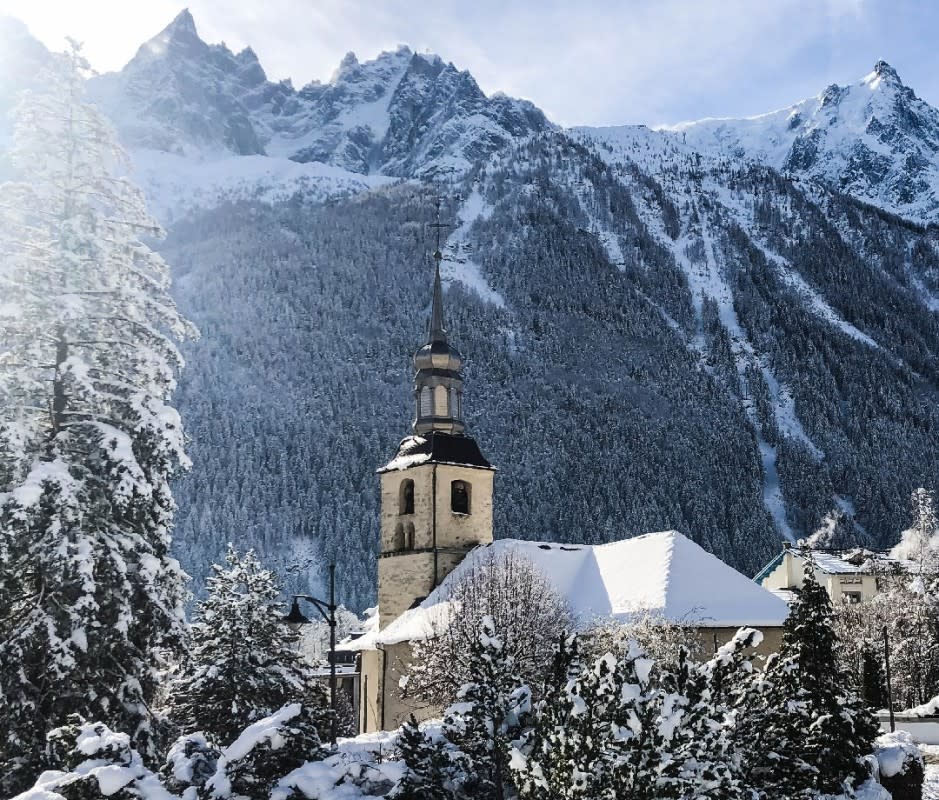
Celia Margerard
Don’t miss the Saint Michel Church with its bell tower, dating back to 1709. Then walk across the bridge (the L’Arve River runs through town), and spend some time roaming the Crystal Museum. Chamonix has long been known for its crystals—dating back to 1741, when a pair of Englishmen (Richard Pococke and William Windham) visited town and walked up the valley to the massive glacier on the northern slopes of Mont Blanc—in search of not just adventure but fabled crystals from the region. Their stories encouraged a flood of tourists (mainly wealthy nobles) to follow them. Chamonix is legendary for its crystal trade, its displays rivaling any we’ve seen worldwide, including the Smithsonian’s collection.
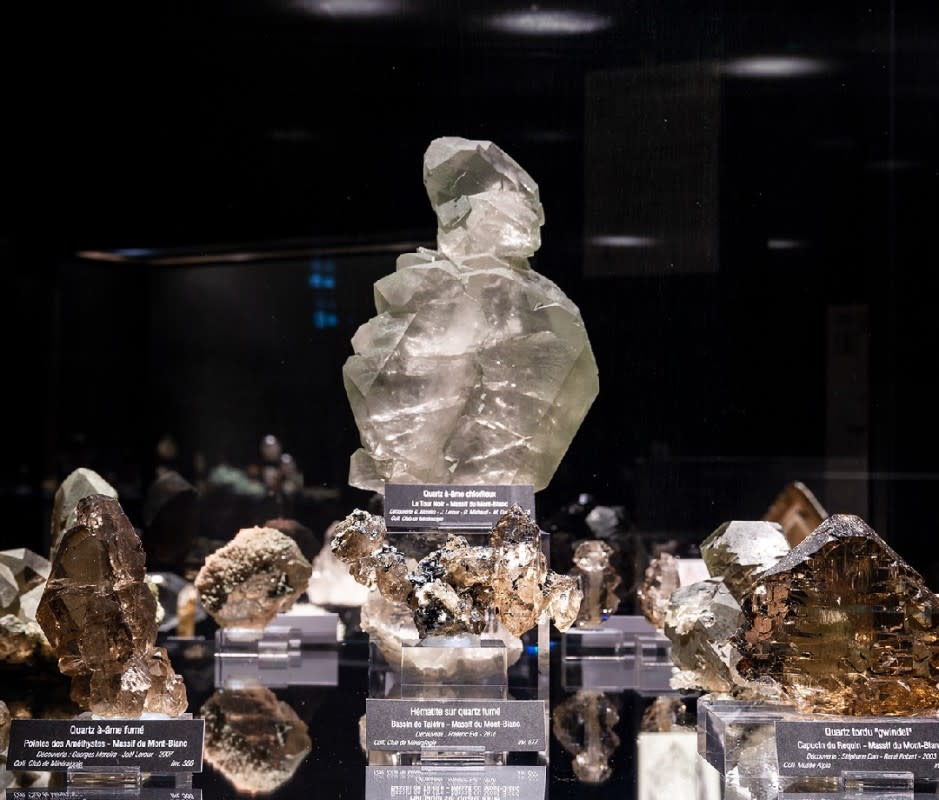
Eric Courcier
Treat yourself to a relaxing afternoon at QC Terme, a world-class wellness spa set in the fields and woods along the banks of the L’Arve. A truly grand spa in the most European sense, this sybarite’s dream is equipped with panoramic infinity pools and whirlpools with extraordinary water features, steam rooms and saunas, hot and cold plunges, foot soaks, and a warm pool with underwater music (soft jazz). Don’t forget to frolic on the first floor of the spa, with its big hammam (steam room) and sauna, as well as several “relaxation” rooms with big swinging chairs. Sink in and soak in the magnificent view of the mountains—and realize that you’re now officially part of this storied valley’s incredible history.
Solve the daily Crossword

